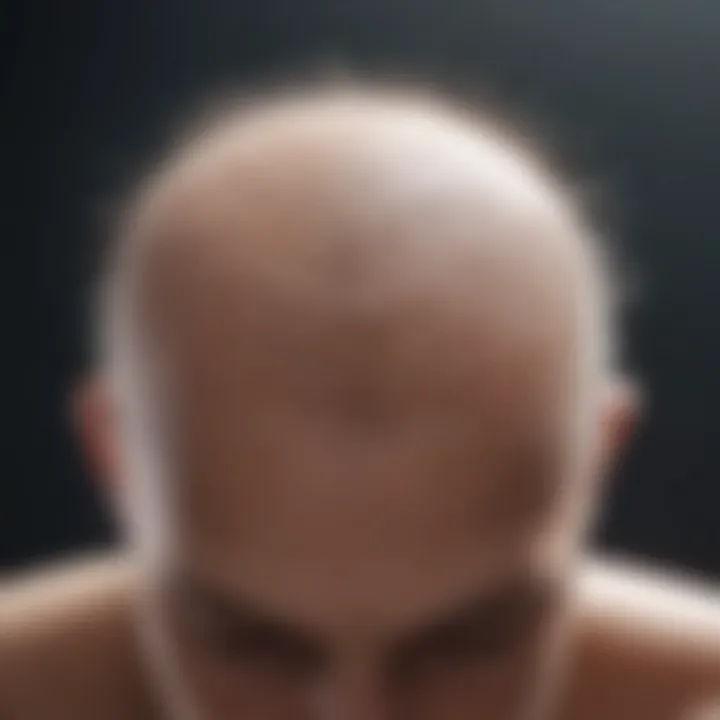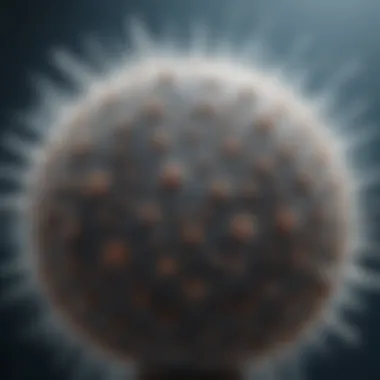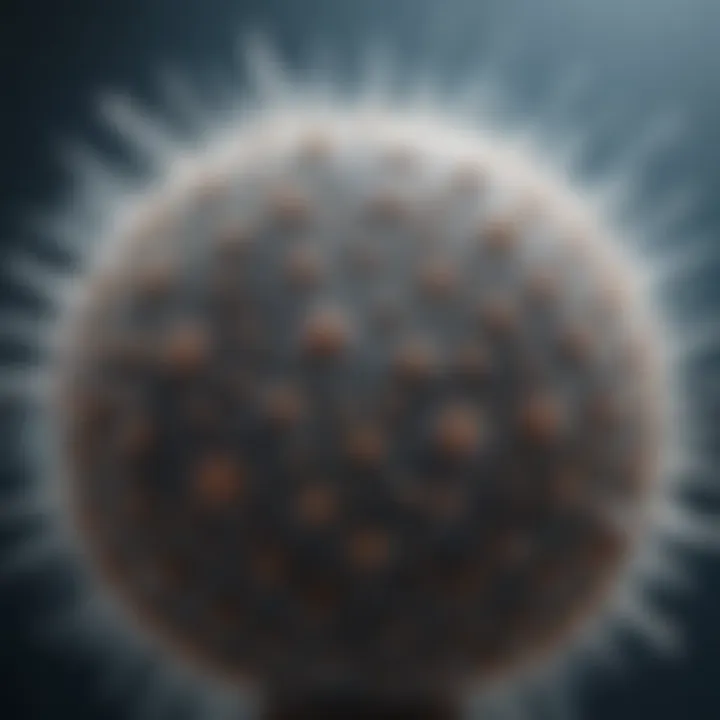Exploring the Causes of Fungal Dandruff


Article Overview
Purpose of the Article
The exploration of fungal dandruff goes beyond mere flakes on the shoulders. The purpose of this article is to unravel the various causes behind this prevalent scalp condition. By doing so, we can provide a thorough understanding that can lead to better management and treatment.
Relevance to Multiple Disciplines
Fungal dandruff intersects with fields such as dermatology, microbiology, and even lifestyle medicine. Understanding it can enhance health education for professionals while providing insights valuable for researchers studying skin conditions.
Research Background
Historical Context
Fungal dandruff has been a term thrown about for decades, but the understanding of it has evolved drastically. In the early days, people attributed the symptoms to poor hygiene, often neglecting the role of microscopic organisms. Fast forward to today, and we know that Malassezia, a type of yeast, plays a significant role in this condition. Many researchers have contributed to this understanding, progressively peeling back the layers of complexity that surrounds fungal dandruff.
Key Concepts and Definitions
Before delving deeper, let’s define some key terms.
- Fungal Dandruff: A scalp condition characterized by excessive flaking and irritation, primarily triggered by fungal infections.
- Malassezia: A naturally occurring yeast found on the scalp, usually harmless, but can lead to dandruff when its growth becomes uncontrolled.
Understanding these terms shapes our grasp of the condition and primes us for the examination of its multifaceted causes.
Prelude to Fungal Dandruff
Understanding fungal dandruff is crucial for anyone grappling with itchy scalps and unsightly flakes. Dandruff isn't just a cosmetic annoyance; it can impact self-esteem and social interactions. When the term 'fungal dandruff' comes into play, it signals that there’s more than just dry skin at work. It suggests a biological underpinning that requires our attention.
This article shines a light on the layers that contribute to fungal dandruff, making it essential reading for students, researchers, and anyone involved in skin health. Not only will the exploration unveil the role of microorganisms, but it will also address various contributing factors, environmental influences, and personal habits that exacerbate this condition. By dissecting these elements, the aim is to provide a holistic view that helps readers recognize the intricacies involved in fungal dandruff—something that often doesn't get the attention it deserves. Additionally, grasping these causes allows for better management and treatment strategies, enhancing overall scalp health.
Delving into fungal dandruff equips individuals with knowledge that may lead to improved conditions, fostering a confident and comfortable lifestyle.
Understanding the Microbial Landscape
In the realm of scalp conditions, understanding the microbial landscape is essential. The scalp is not just a surface; it is a complex ecosystem buzzing with various organisms, predominantly fungi, bacteria, and yeasts. When it comes to fungal dandruff, this intricate web of microorganisms is often right at the heart of the problem. Recognizing how these microbes interact with each other, and with their environment, can shine a light on why some individuals experience persistent irritation and flaking.
Role of Malassezia Yeast
At the forefront of fungal contributions to dandruff is Malassezia yeast. These fungi naturally inhabit the human scalp, playing a dual role. On one hand, they can aid in maintaining a balanced flora, but under certain conditions, they tilt toward the destructive side.
When the scalp’s natural oils increase, perhaps due to hormonal changes or dietary issues, Malassezia can multiply rapidly. As it breaks down the oils for food, it produces irritating fatty acids that may trigger inflammation. This is significant because it creates a vicious cycle: irritation leads to flaking, prompting more oil production in an attempt to soothe the scalp, which in turn feeds more yeast.
Interestingly, not every individual with Malassezia present experiences dandruff. Factors such as skin barrier health and immune response play pivotal roles in determining whether this yeast is a friend or foe.
Other Contributing Fungi
While Malassezia grabs the spotlight, other fungi also contribute to the fungal dandruff equation. Species like Candida and Pityrosporum can be involved. Their roles aren't as widely discussed, yet they can complicate the landscape significantly.
For instance, Candida is often linked to infections in other parts of the body, but can also thrive on the scalp under certain conditions. When the body’s immune system is compromised or when antibiotics skew the microbial balance, Candida may find opportunities to proliferate. This can lead to an exacerbation of an already tricky situation, further complicating the scalp's health.
By understanding these diverse fungi and their interactions, we can better grasp why some individuals develop fungal dandruff while others do not.
"The scalp is a battleground where invisible forces clash, and knowing your enemy is the first step toward victory."
"The scalp is a battleground where invisible forces clash, and knowing your enemy is the first step toward victory."
Summary
The microbial landscape's understanding is crucial for a fuller awareness of fungal dandruff. Malassezia yeast plays a significant role, but other fungi like Candida can also contribute to the challenge. Recognizing these elements gives insight into prevention and treatment options, paving the way for healthier scalp conditions. Paying attention to our scalp's ecosystem and its myriad inhabitants can lead us toward effective methods to tackle fungal dandruff.
Environmental Factors
When exploring the causes of fungal dandruff, one cannot overlook the significance of environmental factors. These are the external conditions that can either exacerbate or alleviate the condition, often creating an interplay with the biological triggers discussed previously. Understanding these elements is crucial, as addressing them can lead to more effective management and treatment options for those struggling with this scalp affliction.
Climate and Humidity
Climate plays a pivotal role in the development of fungal dandruff. High humidity levels, for instance, provide the perfect breeding ground for fungi, notably Malassezia. This yeast thrives in moist conditions, leading to an overgrowth that can provoke inflammation and flaking on the scalp. In contrast, dry climates can result in skin dehydration, which may prompt an increase in dandruff due to the scalp’s inability to maintain its moisture levels.
- High Humidity: Encourages fungal proliferation, leading to aggravated symptoms.
- Dry Climates: May exacerbate flaking as the scalp seeks moisture.
It's worth noting, however, that not everyone reacts the same way to varying climates. Some individuals may find they are more prone to dandruff during transitional seasons when humidity levels fluctuate. Monitoring seasonal changes can be beneficial as one tries to pinpoint personal triggers.
In some tropical regions, fungal dandruff can become epidemic. For example, individuals living in areas such as Southeast Asia often report a significant increase in flaking during the rainy season, illustrating how climate and exacerbating conditions can coincide.
"Environmental conditions can directly influence the health of your scalp, making it imperative to adapt and manage those factors where possible."


"Environmental conditions can directly influence the health of your scalp, making it imperative to adapt and manage those factors where possible."
Pollution and Irritants
Another environmental contributor is pollution. Urban areas, particularly those with high traffic and industrial activity, often harbor numerous pollutants. These can sabotage scalp health by irritating the skin and disrupting its natural balance. Pollutants such as particulate matter, smoke, and chemicals can lead to inflammation, which in turn, can aggravate fungal issues.
- Common Irritants:
- Exhaust fumes
- Dust and pollen
- Industrial byproducts
Exposure to irritants doesn’t only come from the environment. Products used on hair, such as styling gels or sprays, often contain chemicals that can affect the scalp’s flora and fauna. Over time, these substances can diminish the scalp's natural defenses against fungal invasion, increasing the likelihood of developing dandruff.
Adopting preventive measures is crucial for those in polluted environments:
- Regular washing to remove accumulated grime
- Using natural hair products that are free from harsh chemicals
- Covering the hair when in areas with excessive pollution to minimize exposure
Understanding these environmental dynamics empowers individuals to assess their own situations and take steps to effectively manage their scalp health.
By adjusting to the climate conditions and minimizing exposure to pollution and irritants, one can mitigate the severity of fungal dandruff and promote a healthier scalp environment.
Individual Predispositions
Understanding individual predispositions is crucial when exploring the causes of fungal dandruff. This subsection addresses the intrinsic factors that may make certain individuals more susceptible to this condition than others. While environmental influences and lifestyle choices play significant roles, the impact of one's genetic makeup and hormonal balance cannot be overlooked. These factors can determine how the scalp reacts to various stimuli, influencing conditions that might trigger fungal dandruff.
Genetic Factors
Genetic makeup is a powerful determinant in the development of fungal dandruff. Some people are simply born with skin factors that predispose them to certain conditions. For instance, variations in skin barrier function can lead to higher moisture retention or sensitivity to irritants. This increases the likelihood of yeast overgrowth, particularly Malassezia, the yeast most commonly associated with dandruff.
Research has shown that specific genes might affect the production of antimicrobial peptides in the scalp. These peptides play a fundamental role in controlling microbial populations, including fungi. Individuals with lower levels of these protective substances may find themselves more frequently battling fungal issues, including dandruff. In essence, if someone in your family has had persistent dandruff, it might be worth considering whether a genetic disposition is at play.
"Genetic predispositions create a roadmap for how our bodies react to the environment; understanding this can reveal why fungal dandruff occurs in some and not in others."
"Genetic predispositions create a roadmap for how our bodies react to the environment; understanding this can reveal why fungal dandruff occurs in some and not in others."
Hormonal Influences
Hormones are often the puppeteers of many bodily functions, and they certainly influence our scalp health as well. Changes in hormonal levels—be it through puberty, pregnancy, or menopause—can alter oil production in the scalp. Increased oiliness can be a feast for Malassezia, potentially escalating the risk of dandruff.
For example, during puberty, heightened androgen levels lead to increased sebum production. This oil serves as a nutrient source for fungi. Similarly, hormonal shifts during a woman's menstrual cycle can also create fluctuations in sebum production, possibly exacerbating dandruff symptoms.
In addition, hormonal disorders such as polycystic ovary syndrome (PCOS) can produce irregularities in hormonal levels, affecting scalp health. Thus, monitoring hormonal changes and seeking medical advice on how they may influence dandruff conditions can be beneficial.
Lifestyle Contributors
Understanding the role of lifestyle contributors in the development of fungal dandruff is crucial. Factors such as dietary habits and mental health play a significant role in influencing the scalp environment and the overall health of skin. The condition is not merely a topical issue; it extends deep into habits and choices made day-to-day.
Dietary Habits
What goes into your body undoubtedly impacts the condition of your scalp. A diet lacking in essential nutrients can lead to an imbalance in the skin's natural defenses, making it more susceptible to fungal growth. For instance, low intakes of zinc, omega-3 fatty acids, and vitamins like A and E can detrimentally affect scalp health.
- Zinc: It helps regulate the oil production on the scalp, cutting down the excess sebum that often feeds fungi. A shortfall in zinc might encourage such organisms to thrive.
- Omega-3 fatty acids: These play a vital role in maintaining the lipid barrier of the skin, crucial for keeping the scalp hydrated and preventing dryness.
- Vitamins: Vitamin A supports skin cell turnover, while Vitamin E acts as an antioxidant, protecting the skin from damage.
Thus, including foods rich in these nutrients like nuts, fatty fish, and green leafy vegetables can make a substantial difference in managing fungal dandruff. On the flip side, excessive sugar and processed foods can worsen inflammation and create an environment ripe for fungal growth, making careful dietary choices a cornerstone in combating this condition.
Stress and Mental Health
One cannot overlook the psychological aspect when discussing fungal dandruff. Stress is not just a mental state; it manifests physically, affecting the immune system and the body's ability to fend off infections, including fungal ones. High-stress levels can trigger hormonal imbalances that may exacerbate dandruff issues.
Moreover, conditions like anxiety or depression could lead individuals to neglect scalp hygiene, further aggravating fungal growth.
"Your body is a temple, and when it crumbles, so does your health, including your scalp."
"Your body is a temple, and when it crumbles, so does your health, including your scalp."
Addressing mental health through relaxation techniques, therapy, or even mindfulness can have a ripple effect, improving not just one's mental state but also the health of the scalp. Simple practices such as yoga, regular physical exercises, or hobbies can significantly reduce stress levels.
Overall, taking a holistic approach by integrating sound dietary choices and effectively managing stress is not only beneficial for overall health but is also pivotal in keeping fungal dandruff at bay. Ultimately, becoming more aware of these lifestyle contributors can lead to better management of fungal dandruff and healthier skin in general.
Scalp Health and Hygiene
Scalp health plays a pivotal role in our overall well-being and can significantly impact issues like fungal dandruff. Maintaining a healthy scalp is not just about aesthetic appeal; it’s about creating an optimal environment for hair growth and reducing potential irritants that could lead to conditions such as dandruff. Neglecting scalp hygiene can result in an accumulation of oils, dead skin cells, and residue from styling products. These elements can create a breeding ground for the very fungi that contribute to dandruff.
Here are a few key components to consider when it comes to scalp health and hygiene:
- Regular Cleansing: It’s essential to keep the scalp clean, yet the approach may vary depending on individual hair types. For oily scalps, more frequent washing may help keep the sebaceous activity in check. In contrast, dry scalps may benefit from less frequent washing paired with moisturizing shampoos.
- Choosing the Right Products: The impact of hair products cannot be overstated. Many shampoos and conditioners contain sulfates, parabens, and alcohol, which can worsen dandruff by drying out the scalp or causing irritation. Opting for gentle, sulfate-free, or natural hair care products can foster a healthier scalp environment.
- Massage Techniques: A simple scalp massage during washing can boost circulation and encourages exfoliation. This action not only feels good but helps in the sloughing off of dead skin and, in doing so, may minimize flaking associated with dandruff.
"A clean scalp is like a healthy foundation for a house; without it, everything built on top remains fragile."


"A clean scalp is like a healthy foundation for a house; without it, everything built on top remains fragile."
Furthermore, it’s crucial to monitor how the scalp reacts post-wash. If irritation increases or dandruff appears after using a new product, it may be a sign that the product does not suit your scalp’s needs. Keeping a close eye on how your scalp responds will inform better hygiene and care practices moving forward.
Impact of Hair Products
The products we use on our hair can dramatically impact scalp health and, subsequently, the presence of fungal dandruff. Hair sprays, gels, and waxes often leave behind residues that accumulate on the scalp if not washed out properly. Products containing heavy fragrances or harsh ingredients can irritate the skin, leading to inflammation that may promote fungal growth.
- Fragrance and Irritants: While scent is an integral part of many beauty products, synthetic fragrances can cause allergic reactions or sensitivities, especially for those with pre-existing skin conditions.
- Alcohol Content: Many styling products contain alcohol, which may initially provide a satisfying hold but can dry out the scalp. This dryness might trigger compensatory oil production, creating a cycle that can exacerbate dandruff.
- Residual Build-Up: Continuous use of multiple products without adequate cleansing can lead to build-up. It’s important to periodically clarify the scalp using specific shampoos designed to remove product residues, ensuring a clean and healthy environment for the skin.
Frequency of Washing
The frequency of washing hair is a highly personal choice, yet it carries significant weight in managing scalp health. This aspect largely depends on individual hair types, lifestyles, and activities. For instance:
- Active Individuals: If you exercise frequently or work in a hot, humid climate, washing your hair more often may help manage scalp oils and prevent fungal overgrowth.
- Drier Scalps: If one tends to have a naturally drier scalp, reducing the washing frequency might help retain natural oils, minimizing flaking due to dryness.
- Adopting a Routine: Establishing a washing routine that balances moisture and cleanliness can enhance scalp condition. For example, using a mild shampoo every few days while incorporating a light conditioner can maintain hydration without over-washing.
Ultimately, understanding that scalp health and hygiene are integral to preventing fungal dandruff helps demystify this common issue. A well-cared-for scalp lays the groundwork for healthier hair and reduces susceptibility to conditions that lead to irritation and flaking.
Diagnosis and Recognition
The process of diagnosing fungal dandruff is a vital step towards effective management of the condition. Identifying the exact type of dandruff allows healthcare providers to implement appropriate treatment protocols. Without proper diagnosis, one might approach their dandruff issue with the wrong remedies, leading to prolonged discomfort or worsening symptoms. Recognition entails understanding not only the symptoms but also the broader context surrounding the individual's scalp health.
Clinical Features
In grappling with fungal dandruff, multiple clinical features present themselves as telltale signs. These include:
- Flaking: Often seen as white or yellowish scales on the scalp; these flakes may shed onto clothing.
- Itching: A frequent indicator of an underlying fungal condition; the urge to scratch can exacerbate skin irritation.
- Redness: The inflamed area of the scalp can turn red, especially where scratching occurs.
- Oily Scalp: A greasy feeling on the scalp may coexist with the typical dry flakiness of dandruff.
In addition to these features, individuals may notice changes in their hair’s texture or thinning of hair due to vigorous scratching. However, not every instance of flaking or itching indicates fungal dandruff. For instance, conditions like psoriasis and eczema resemble these symptoms but require different treatments. It is imperative to consult a healthcare professional for a comprehensive evaluation to distinguish between these conditions.
"Fungal dandruff might seem trivial, yet its implications on comfort and self-esteem are significant. Identifying it promptly preserves both scalp health and personal well-being."
"Fungal dandruff might seem trivial, yet its implications on comfort and self-esteem are significant. Identifying it promptly preserves both scalp health and personal well-being."
Methods of Diagnosis
Diagnosing fungal dandruff effectively involves several steps to rule out other scalp ailments. Here's a breakdown of common methods:
- Visual Inspection: A healthcare professional typically begins with a thorough examination of the scalp to identify clinical features.
- Scalp Biopsy: In certain cases, removing a small sample of the affected area for laboratory examination can clarify the diagnosis. This is particularly helpful if there are ambiguous symptoms.
- Culture Tests: Conducting fungal culture tests on sample skin scrapings can pinpoint the specific type of fungus responsible for the dandruff. This can help tailor treatment.
- Microscopic Examination: Dermatologists may employ a microscope to analyze the composition of the flakes directly on-site, enabling quick identification of fungal elements.
- Medical History Review: Assessing the individual's personal and familial health background often reveals patterns that inform the diagnosis. Factors like stress, diet, and existing medical conditions might contribute to dandruff.
These diagnostic methods combine to provide a clear picture of the underlying causes of dandruff, allowing for a personalized treatment plan that addresses both the symptoms and root causes.
By understanding the clinical features and methods of diagnosis, individuals can take informed steps towards managing their fungal dandruff effectively.
Management and Treatment Options
Managing fungal dandruff effectively requires an understanding of the various approaches available. This section is crucial as it outlines the differences between over-the-counter treatments and prescription remedies, catering to diverse needs and preferences. These methods are not just about alleviating symptoms; they also work towards addressing the underlying causes of the condition, making them essential for achieving long-term relief.
Over-the-Counter Treatments
When it comes to tackling fungal dandruff, over-the-counter treatments offer a convenient entry point for many. These products are at the disposal of anyone who struggles with symptoms, allowing for direct and easy access without requiring a prescription. Common ingredients in these treatments include:
- Ketoconazole: This antifungal agent actively combats fungal growth and is often found in shampoos designed specifically for dandruff.
- Selenium sulfide: Known for reducing scalp flaking, it also lessens the growth of yeasts.
- Zinc pyrithione: It offers antifungal and antibacterial properties, making it effective against a variety of scalp issues.
Using these treatments is relatively straightforward. Typically, they involve applying the product directly to the scalp, leaving it on for a specific duration, and then rinsing. It is advisable to follow the instructions on the packaging closely for maximum benefit. While many find relief with these OTC options, it's essential to consider a few key points:
- Consistency is crucial: Regular use, often recommended several times a week, can help prevent flare-ups.
- Observe your scalp's reaction: If irritation or worsening symptoms occur, it may be necessary to discontinue use.
- Patience and persistence: Sometimes, improvements take time.
In short, over-the-counter treatments serve as a first line of defense, offering a blend of convenience and efficacy that many people appreciate as they navigate their dandruff journey.
Prescription Remedies
For those who do not find sufficient relief from over-the-counter options or have more severe symptoms, prescription remedies may be necessary. These treatments often contain higher concentrations of active ingredients and can target the condition more aggressively. Key prescription treatments include:
- Stronger antifungal shampoos: Sometimes, dermatologists might prescribe shampoos with more potent formulations that may not be available in retail settings.
- Topical corticosteroids: These can help manage inflammation associated with dandruff, reducing itchiness and redness in the process.
- Systemic treatments: In some cases, oral medications may be prescribed for more significant infections or persistent problems.
Visiting a dermatologist is the best way to assess whether a prescription remedy is suitable. They will likely conduct an examination to determine the root causes, helping to tailor a treatment plan that suits individual needs. Key considerations to keep in mind:
- Follow-up appointments: Regular appointments with a healthcare provider help monitor progress and adjust treatments as needed.
- Potential side effects: Understanding side effects that might occur from stronger medications is vital.
- Lifestyle integration: Adapting treatment with lifestyle changes can significantly enhance outcomes.
To wrap it up, a strategic approach that encompasses both OTC and prescription treatments can significantly impact managing fungal dandruff effectively and sustainably. As the saying goes, "An ounce of prevention is worth a pound of cure." All in all, thorough understanding and proactive management can keep those pesky flakes at bay.
Home Remedies and Natural Approaches
When it comes to addressing fungal dandruff, many people often look towards conventional treatments first. However, it’s essential to explore home remedies and natural approaches, which can offer relief and may even complement medical treatments. These methods are often more accessible and can be tailored to individual preferences. Natural remedies can also minimize the risk of side effects commonly associated with commercial products, thus making them an appealing option for those seeking gentler alternatives.


Essential Oils
Using essential oils is one of the popular natural remedies for fungal dandruff. Different oils have unique properties that can combat fungal growth and soothe the scalp. For instance, tea tree oil is often touted for its antifungal and antibacterial benefits. Research suggests that it can effectively reduce the irritation and flaking associated with fungal dandruff.
Another essential oil worth mentioning is lavender oil. This oil not only has a pleasant aroma but also helps in maintaining scalp health due to its calming effects. It can help reduce inflammation and create a better environment for a healthy scalp. Moreover, peppermint oil is known for its invigorating sensation. It improves circulation, which may help in promoting a healthy scalp while also offering some antifungal properties.
"Nature has its own pharmacy."
"Nature has its own pharmacy."
When using essential oils, it’s crucial to dilute them with carrier oils like coconut or jojoba oil before application. This not only minimizes the risk of irritation but also enhances the moisturizing effect on the scalp. Regular application of these oils may offer a gradual improvement, but consistency is key. While they provide a natural avenue, it’s essential to be patient and monitor any changes in your scalp condition.
Dietary Adjustments
Diet plays an indispensable role in overall health, and it extends to scalp health as well. Making certain dietary adjustments can potentially reduce the occurrence of fungal dandruff. Nutrient-rich foods can bolster the immune system, which helps to keep fungal infections at bay.
Incorporating foods rich in omega-3 fatty acids, such as salmon or flaxseeds, may offer anti-inflammatory benefits. These can contribute to a less irritated scalp and support skin health. Moreover, incorporating probiotics, found in yogurt and fermented foods, can promote a healthy gut microbiome, which in turn can have a positive impact on skin and scalp health.
Additionally, limiting the intake of sugary foods and processed snacks can be beneficial. Research indicates that high sugar consumption can exacerbate fungal growth. Thus, a diet focusing on whole grains, fresh fruits, and vegetables can create an unfavorable environment for fungi.
In the end, it's wise to take a holistic approach: while managing fungal dandruff, combine natural remedies with mindful dietary choices. These adjustments not only aim to alleviate the symptoms but also support overall well-being.
Preventive Measures
Preventive measures play a crucial role in managing fungal dandruff. The idea here is to keep the scalp environment unfriendly to yeast and other fungi that contribute to the condition. Prevention is often easier than treatment; hence, understanding the various strategies can lead to better scalp health and fewer flare-ups. By incorporating good practices into daily routines, individuals can significantly reduce the risk of developing fungal dandruff.
Scalp Care Techniques
Taking care of the scalp is essential in preventing fungal dandruff. Here are several techniques that can help:
- Regular Cleansing: Keeping the scalp clean is paramount. Use a gentle shampoo at least two to three times a week to remove excess oils and dead skin cells that can foster fungal growth.
- Exfoliation: Like the skin on your face, the scalp can benefit from occasional exfoliation. Products specifically designed to exfoliate help to clear away buildup and promote healthy skin renewal.
- Moisturizing Products: While too much oil can worsen dandruff, a well-moisturized scalp can prevent dryness that may trigger flaking. Look for products that are lightweight and suitable for your scalp type.
- Avoiding Harsh Chemicals: Be cautious with hair products containing strong chemicals. They can irritate the scalp, making it more vulnerable to fungi. Opt for sulfate-free shampoos and conditioners whenever possible.
Implementing these techniques can significantly enhance scalp health, developing a less hospitable environment for fungal growth.
Lifestyle Adjustments
The lifestyle choices we make can also influence the prevalence of fungal dandruff. Here are some adjustments that can help:
- Balanced Diet: Eating a nutrient-rich diet helps your body fend off infections. Incorporate foods high in vitamins A, E, and omega-3 fatty acids to nourish the scalp and skin.
- Hydration: Staying hydrated is often overlooked. Adequate water intake helps maintain skin elasticity and can prevent dryness, which might contribute to dandruff.
- Stress Management: Stress has a peculiar way of affecting overall health, including skin health. Techniques such as mindfulness, yoga, or simply taking time to relax can create an indirect positive impact on your scalp condition.
- Limit Heat Styling: Regular use of heat tools can dry out the scalp and damage hair. Limiting heat exposure helps maintain scalp health and reduces dandruff risk.
Incorporating these lifestyle adjustments not only fosters a healthier scalp but also enhances overall well-being.
"Prevention is better than cure." - It rings true when considering how to deal with fungal dandruff.
"Prevention is better than cure." - It rings true when considering how to deal with fungal dandruff.
By focusing on these preventive measures, individuals can enjoy healthier scalps and mitigate the impact of fungal dandruff.
The Role of Research in Understanding Fungal Dandruff
Research plays a critical role in our understanding of fungal dandruff, shedding light on its underlying mechanisms and potential treatment options. The investigation into this common condition is not merely academic; it has real-world implications for those affected by it. With millions of people tackling this issue, the knowledge gleaned from research can lead to better diagnostic methods, enhanced treatment strategies, and more effective prevention measures. This section delves into some crucial aspects of ongoing research and its profound benefits in managing fungal dandruff.
Current Research Trends
In the ever-evolving landscape of dermatological science, studies concerning fungal dandruff are progressively becoming more nuanced. Recent trends focus on:
- Exploration of Microbiomes: Researchers are delving into how the diverse range of microorganisms that inhabit the scalp interact. The balance between beneficial microbes and pathogenic fungi like Malassezia is crucial. Disruptions in this balance appear to lead to dandruff flares.
- Biomarkers for Diagnosis: The identification of specific biomarkers is gaining traction. These markers could facilitate faster and more accurate diagnosis, enabling targeted treatments tailored to the individual's scalp conditions.
- Link Between Diet and Dandruff: There's an increasing body of evidence suggesting dietary choices may affect the occurrence of fungal dandruff. Studies are looking into the impacts of certain nutrients, like omega-3 fatty acids and probiotics, on scalp health and fungal populations.
- Stress and Immune Response: Researchers are investigating how psychological stress correlates with flare-ups of dandruff. Understanding this relationship can lead to holistic treatment approaches that incorporate stress management into care plans.
"Understanding that fungal dandruff may not just be a cosmetic issue, but rather a complex interaction of biological, environmental, and psychological factors, is key to effective treatment."
"Understanding that fungal dandruff may not just be a cosmetic issue, but rather a complex interaction of biological, environmental, and psychological factors, is key to effective treatment."
Future Directions
The future of research into fungal dandruff holds promising avenues that could revolutionize management strategies. Some anticipated directions include:
- Advanced Genomic Studies: With the price of genomic sequencing dropping, investigations into the genetic predispositions that lead to dandruff could unveil new treatment avenues. This knowledge might allow for personalized medicine approaches that cater to individual genetic backgrounds.
- Innovative Treatment Approaches: Research is likely to focus on breaking ground with novel antifungal substances and delivery systems that could enhance the efficacy of existing treatments.
- Integration of Technology in Diagnostics: Leveraging artificial intelligence and machine learning tools may emerge as powerful methods for analyzing patient data, allowing for predictive models that avert severe flare-ups before they occur.
- Community-Based Research Initiatives: Engaging communities in research to understand environmental factors that contribute to dandruff is expected to grow. This can help localize treatment options and preventive measures in different demographics.
Culmination
In wrapping up our examination of fungal dandruff, it is crucial to appreciate the multifaceted nature of the condition. This article has laid bare the intricate web of causes that contribute to fungal dandruff, underscoring that it is not merely a superficial annoyance, but a manifestation of underlying microbial interactions, environmental complexities, and individual health factors. The importance of understanding the nuances of this condition cannot be understated.
Summary of Key Points
- Fungal Origins: At the core of fungal dandruff is Malassezia, a common yeast on the scalp. Its overgrowth can lead to flaking and itchiness.
- Environmental Factors: Humidity, pollution, and irritants play significant roles in the severity and frequency of outbreaks.
- Personal Predispositions: Genetic makeup and hormonal changes can predispose individuals to develop more severe forms of dandruff.
- Lifestyle Influences: Dietary choices, stress levels, and overall scalp hygiene are directly linked to the health of one’s scalp, further complicating the condition.
"Understanding these factors offers a clearer path to effective management and treatment, moving beyond mere symptom relief to addressing root causes."
"Understanding these factors offers a clearer path to effective management and treatment, moving beyond mere symptom relief to addressing root causes."
Final Thoughts
Fungal dandruff can be a tricky opponent. From the myriad of contributing factors, it's clear that any approach to treatment should be holistic. Awareness and education stand as the first lines of defense; the more individuals know about what triggers and exacerbates their condition, the better prepared they are to manage it effectively. Consideration should be given not only to medical treatments but also to lifestyle adjustments and preventive measures. In doing so, one can move towards a healthier scalp and a significant reduction in the discomfort associated with this common ailment. As research continues to evolve, we remain hopeful for new insights and innovations that can further aid in understanding and combating fungal dandruff.



